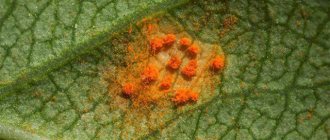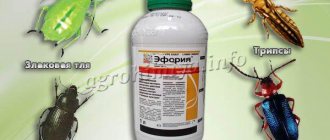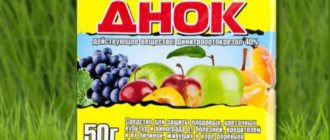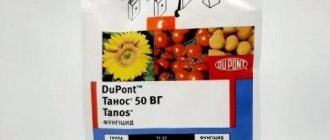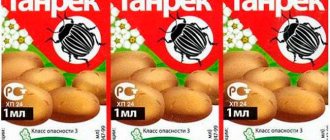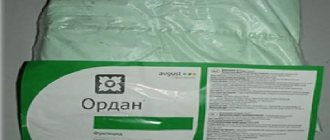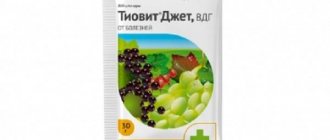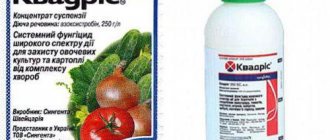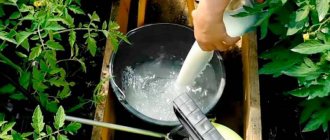Instructions for use of the drug Brunka
The drug Brunka can have a strong effect only if used correctly and a number of rules are followed.
The components that are present in the composition are absolutely safe for humans if they are in moderate quantities. The product is used in the form of a solution. The instructions for the Brunka fungicide are as follows:
For comprehensive plant protection, two sprays per year will be enough. The first event is carried out in early spring before flowering begins, and the second in late autumn, when the plant begins to prepare for winter. In some cases, additional processing of the fruit tree may be required. Then it is carried out immediately after flowering, and the amount of the drug is also halved. The dosage for standard treatment is 30 ml per bucket of water (10 l). The amount of Brunka for grapes and berry bushes is reduced to 20 ml
A measured amount of the chemical must be dissolved in a small volume of liquid, and then the solution must be added to the rest of the water. It is recommended to use the prepared product immediately, since in its finished form it can be stored for no more than two days. It is extremely important to take precautions and not come into direct contact with active substances. During processing, you must ensure that there are no children or pets nearby. Containers that were used to prepare the solution cannot be used for another purpose.
Also, when spraying, you must equip yourself with protective equipment: gloves, a respirator and goggles.
Immediately after treating the area, remove protective clothing and take a shower. Only after this can you eat or smoke. It is worth noting that drinking alcohol can enhance the effects of toxins. It is allowed to begin work on the garden plot only three days after treatment with this drug.
Safety regulations
Brunka fungicide is a drug of moderate toxicity to humans and animals, so handling it requires special care:
- Direct contact with the substance should be avoided;
- it can only be transported in a hermetically sealed container;
- when spraying trees, the presence of children and animals in the immediate vicinity of the site is not allowed;
- containers that were used to prepare a working solution of Brunka fungicide and subsequent spraying cannot be used for other purposes;
- Before starting work, you need to check the serviceability of the sprayer;
- When preparing the solution and processing plants, it is necessary to use personal protective equipment - rubber boots and gloves, a respirator, goggles, a work coat or overalls.
When treating plants with Brunka fungicide, it is important to choose the right time:
- Spraying should be carried out in the morning or evening;
- if the treatment is carried out during the daytime, you need to choose a cloudy day - in hot weather the solution quickly evaporates, and its toxic fumes saturate the surrounding air;
- It is not recommended to spray in windy weather.
Advantages and disadvantages
According to reviews from experienced gardeners, Brunka is a reliable and effective remedy. However, any fungicide has its own strengths and weaknesses.
Advantages of this tool:
- It has a complex effect (eliminates not only insects, but also larvae).
- Completely safe for plants since there are no toxic decomposition products.
- Capable of eliminating overwintering harmful insects.
- Differs in breadth of use against various parasites.
- Long lasting protection as the product can be applied twice a year.
- Eliminates kidney mites and gall aphids, unlike other drugs.
- Promotes foliar feeding of the tree, since useful microelements are released during the breakdown of active substances.
- Does not have a herbicidal effect.
- It is allowed to use the product at the initial stage before flowering.
- Blocks germinating spores of pathogenic mycelium.
Despite the large number of positive qualities, the drug also has some disadvantages: high cost and the presence of dyes. Gardeners also note that the drug can slightly inhibit leaf blossoming, but this factor does not affect the yield of plants.
Advantages of the drug
The advantages of Brunka fungicide are:
- complex impact with a wide spectrum;
- destruction of wintering pests;
- blocking germinating spores of pathogenic mycelium;
- the absence of harmful decomposition products that have a detrimental effect on trees and fruits;
- release of useful microelements during decay, acting as foliar feeding;
- a small number of treatments, unlike other drugs;
- lack of herbicidal properties and severe burns of foliage;
- weak degree of coloring compared to other substances;
- Possibility of use at the initial stage of bud opening.
The drug Brunka also has some disadvantages:
- it has a slight coloring effect, but to a lesser extent than other drugs;
- The fungicide is quite expensive, although its price is justified.
It has also been noted that the Brunka fungicide, according to reviews, slows down the blossoming of leaves for a short time, but in the future this factor is quickly compensated.
Consumption rates
The product is used in volumes:
· 10 l/100 sq. m - to protect apricot, peach, cherry, plum from the wintering stages of mites, scale insects, aphids, moths, leaf rollers, copperhead, as well as from diseases: clasterosporiasis, coccomycosis, spotting, moniliosis, curl.
· 15 l/100 sq. m - to protect apple, pear, quince trees from the wintering stages of psyllids, pseudoscale insects, moths, copperheads, moths, leaf rollers, aphids, mites, scale insects, as well as diseases such as scab, moniliosis, etc.
· 8 l/100 sq. m - to protect grapes from wintering stages of pests and parasites (mites, scale insects, etc.), as well as from anthracnose, cercospora blight, oidium, spotted necrosis and other diseases.
· 15 l/100 sq. m - to protect currants and gooseberries from the wintering stages of scale insects, false scale insects, copperheads, moths, aphids, leaf rollers, scale insects, and mites. And also against powdery mildew, anthracnose, septoria, rust.
Scope of use
It is used for processing trees (fruit and ornamental), shrubs, and vineyards. The product is used by gardeners to remove pests, for example:
- Apple and pear trees: used to combat insects and diseases such as scale insects, aphids, psyllid, scab and others.
- Plums, cherries and apricots: against lichens, mites, leaf rollers, moniliosis and other problems.
- The drug "Brunka" for grapes helps to cope with wood borers, spotted necrosis and other pathologies and harmful organisms.
It is important to know about the storage time of the Brunka solution. The instructions for use instruct you to get rid of it no later than 24 hours after application.
Networks recommend
For those who still dare to use it and want to know how plants are treated with the Dnok fungicide, the instructions should be carefully studied.
· Gardeners recommend covering it with plastic film before processing in order to prevent poisoning of the soil microflora. This will preserve the life of bacteria, microbes, worms and other beneficial inhabitants of the soil, stimulating the formation of humus and increasing the fertility of the soil.
· Users also mention a new drug - this is the insectoacaracid-fungicide “Brunka”, an analogue of “Dnoka”, which is approved for use on household plots and summer cottages in the CIS countries.
According to reviews, “Dnok” effectively helps against pests and tree diseases. Gardeners talk about how plants were treated using the Dnok product. How to dilute the product? We will definitely consider this, but a little later. In the meantime, let's talk about time and processing methods.
· It is necessary to mix the fungicide and “Preparation No. 30” - the mixture will not be washed off by precipitation for a long time, which is very helpful in the fight against scab and scale insects.
· “Dnok” should be used in the fall after leaf fall.
· It has been noticed that the use of nitrogen compounds when treating plants in the fall reduces their frost resistance. By using the drug in the spring, you can get the effect of abundant fertilizing with nitrogen fertilizers. At the same time, gardeners noticed that all the plant’s energy goes not to fighting pests, but to the development of foliage and shoots.
· It is also advised to treat fallen leaves with urea and bury them in trenches one and a half bayonets deep. With the arrival of spring, apply “Dnok” together with “Preparation No. 30”, and urea in the spring of next year.
Instructions
The drug is used in the form of an active solution. To prepare it you need 30 ml of product per 10 liters of water. First, the drug is diluted in a small amount of water, after which the volume of liquid is adjusted to the required volume. It is best to carry out processing on a sunny, clear day. it is necessary to adhere to the method of application of the fungicide according to the information provided on the drug label.
The drug does not have the ability to cauterize; it only briefly slows down the blossoming of leaves, however, as summer approaches, this factor makes up for. The fungicide is effective for 30-40 days after spraying. The 350 ml form of fungicide is the most optimal volume for treating trees and shrubs in the gardens of amateur gardeners, however, larger volumes are provided for professional use.
- It has a wide spectrum of action, as it combines the properties of an insectoacaricide and a fungicide, which can significantly reduce the number of planned treatments and reduce costs.
- It does not have any residual decay products, which guarantees an environmentally friendly harvest.
- It can be used at an early stage of kidney development, which contributes to their full development in the future.
- Gives effective results in just two applications per year.
- Gives leaf color, but several times less than other similar preparations.
- When residual substances decompose, microfertilizer is formed, which nourishes the plant and acts as a growth stimulator.
- It is the only drug that effectively fights gall aphids and kidney mites.
It was also noted that, unlike other preparations, brunka does not have a herbicidal effect on crops, but only slightly slows down the growth process for a while.
Along with all the advantages, there are also disadvantages of the Brunka fungicide. These include:
- high cost of the product;
- coloring effect.
Brunka, LiveJournal – a garden without diseases and pests ⋆ buy cheap
Brunka, LJ – a four-component systemic insecto-fungicidal preparation for the protection of trees, shrubs, and vineyards. The pesticide effectively protects against fungal diseases and their pathogens, as well as against harmful insects. Moreover, the chemical acts as both a therapeutic and a prophylactic agent.
Exposure components: phosphorous acid, 530 g/l; aluminum phosphite, 240 g/l; imidacloprid, 125 g/l; lambda-cyhalothrin, 10 g/l. That is, fungicidal components like Fital.
Release form: liquid/liquid.
Action
Action
The drug has a multifunctional effect on harmful organisms that attack the treated plant. Namely, an effective combination of active ingredients effectively protects the crop and has an acaricidal effect.
Phosphorus
Phosphorus
Phosphorous acid, whose formula is H2(PHO3), is an inorganic substance. That is, it is a dibasic acid, but in form it is a tribasic acid of medium strength.
It directly affects pathogens by penetrating the crop during spraying. Moreover, H2(PHO3) is synthesized inside the body during the hydrolysis of AlPO3.
That is two in one.
Aluminum phosphite, whose formula is AlPO3, is generally also an inorganic substance. Namely, AlPO3 has the fastest possible hydrolysis, creating phosphorous acid. That is, this component effectively influences the therapeutic and preventive capabilities of Brunka.
Imidacloprid
Imidacloprid
Imidacloprid effectively protects the crop from the wintering stages of harmful insects. In general, the insecticide stops the transition of the nervous impulse of pests at the very start. Moreover, this chemical can move freely within the crop and has an effective anti-stress effect.
Lambda-cyhalothrin
Lambda-cyhalothrin
Lambda-cyhalothrin is a contact active component that penetrates the cuticle into the insect’s body. The component produces nerve impulses in the insect's nervous system.
Namely, this leads to increased nervous activation and an immediate loss of control of the body.
That is, the chemical is much more active in eliminating a much wider range of insects than other pyrethroids.
Thanks to phosphorous acid, insecticides quickly enter the plant and spread along with sap flow. The drug actively destroys oviposition and overwintered phytophages.
Application of Brunka
Application of Brunka
The pesticide is used in gardens and vineyards twice a year, 2 l/ha.
- Firstly, in the spring from the opening of the buds to the formation of inflorescences.
- Secondly, in the fall before the leaves fall.
The consumption of the working mixture is from 400 liters to 1 cubic meter per hectare.
Pros of the chemical
Pros of the chemical
- Wide range of insecticidal, acaricidal and fungicidal effects. That is, it destroys all harmful organisms.
- Long period of pesticide activity.
- Easily used in cottages and gardens.
- Comfortable to use.
Sharing and analogues
A unique feature of the drug “30 Plus” is that it can be mixed with almost all plant protection products.
The protection of plants from mites, thrips, leafhoppers and aphids is significantly more effective when the drug “30 Plus” is used together with other insecticidal or acaricidal drugs.
And if you carry out joint treatments with fungicides, you can observe the so-called synergistic effect. Such mixtures ensure long-term retention of drugs on the branches and bark of plants due to the oily film, which blocks the germination of spores of harmful fungi, due to the fact that moisture does not accumulate on the vegetative parts of plants.
When treating vineyards, it is advisable to use the drug “30 Plus” together with acaricides to protect against felt mites, and when used together with fungicides to protect against anthracnose and black spot.
Also, the drug “30 Plus” is used in conjunction with herbicides, adding it to the working solution and ensuring the preservation of the drugs on the fleecy and waxy surfaces of plant leaves.
There are no worthy analogues of the drug “30 Plus” today.
What is special about the drug?
In order to understand the essence of the action of this remedy, it is necessary to understand its component parts. Brunka contains three active ingredients:
- lambda-cyhalothrin;
- imidacloprid;
- aluminum phosphide.
The combination of these three components helps the drug effectively cope with various types of pests as an insecticide, with fungal diseases of crops as a fungicide, and also has a suppressive effect on the microflora of moss, which prevents its further development.
Since these active ingredients have different minimum temperatures of action, this must be taken into account and treatment must be carried out at the optimal temperature for all components of the drug - not lower than 12 degrees and not higher than 20 degrees.
The most important component of the product is phosphorous acid; thanks to its action, the active components penetrate into plant tissue, as well as into laid pest eggs, into hibernating hibernating individuals and into fungal formations at the cellular level. This occurs within 20-30 minutes after treatment.
It is phosphorous acid that makes the Brunka preparation special, with such lightning-fast action and provides effective plant protection throughout the entire period of action. Thanks to the contact action, crops are also protected from the outside. In contrast to the characteristics of the treated crops, the duration of the drug can vary between 30 and 40 days.
Brunka fungicide is necessary for treating ornamental and fruit trees, grapes and berry bushes in accordance with the instructions for its use.
Composition and principle of action
The composition contains three active components. Aluminum phosphide is the main substance that has a toxic effect on the respiratory organs and nerve cells of insects. The effect of the substance occurs half an hour after penetration.
Imidacloprid - the substance has a paralytic effect, blocks ion exchange in the synapses of nerve cells of pests, and is absorbed through the intestines. Valid for a month.
Expert opinion
Zarechny Maxim Valerievich
Agronomist with 12 years of experience. Our best country expert.
Ask a Question
Lambda-cyhalothrin is an insecticide that acts as an active substance against most insect pests.
The chemical substance “Brunka” is known to gardeners due to its complex action and deep penetration. The product protects tree leaves from caterpillars and their larvae, and gets rid of ticks. After applying the drug, a chemical reaction occurs and substances are released: copper and phosphorus. Stimulants have a positive effect on the growth and development of young shoots.
After blooming
For very neglected gardens, it is advisable to carry out another treatment (after flowering). The method of applying the Brunka fungicide after bud break is somewhat different. In order not to harm future fetuses, the dosage is halved - 15 ml per 10 liters of water.
The last treatment is carried out in late autumn. The standard dosage is 30 ml per 10 liters of water.
Brunka fungicide is available in the form of a soluble concentrate. It can be used to treat both fruit and ornamental trees. The drug is available in 30 ml, 150 ml, 350 ml bottles. Large volumes are provided for professional treatments. The price of a 30 ml package is about 100 rubles, a 250 ml package is about 500 rubles.
Number of treatments
Two sprays with Brunka per season are enough for effective plant protection:
- the first is carried out in early spring, before the buds have time to open;
- the second - in late autumn, when the plant is preparing for winter.
Sometimes, if the trees are very neglected, another treatment with Brunka is allowed. It is usually carried out after flowering has ended. To minimize the harm caused to plants, when spraying again, the dosage of the drug is halved.
The commercial form of release of Brunka fungicide, depending on the method of application and price, is a soluble concentrate with the following volume:
This packaging is very convenient for summer residents and amateur gardeners, but farmers need significant volumes. The cost of the smallest package of Brunka fungicide is 100 rubles. For basic treatments, the dose of the substance is 30 ml per bucket of water. First, a measured amount of the drug is dissolved in a small amount of water, then the mixture is diluted to the required volume. The prepared working solution can be stored for no more than a day. Remains of used substance must be disposed of.
Fungicide
Gardeners have long adopted the low-toxic fungicide Brunka. It is used to treat grapes, fruit trees and shrubs against pests. The drug is multicomponent, has fungicidal, insecticidal, acaricidal properties. To destroy larvae and adults, two treatments per season are sufficient.
Description
Brunka is an insecticide and fungicide in one bottle. The new generation drug is used to protect trees and shrubs from pests, fungal infections, and mosses. The substances included in the composition act on adult insects, larvae and eggs.
Compound
The complex effect of the drug is possible thanks to 3 active components. They complement each other in their ways of influencing pests and improve absorption.
| Active substance | Concentration (g/l) |
| phosphorous acid | 530 |
| aluminum phosphide | 240 |
| imidacloprid | 125 |
| lambda-cyhalothrin | 10 |
The release form of the fungicide is a soluble concentrate. In gardening stores you can find containers with the following volumes:
A bottle of minimum volume (30 ml) costs 100 rubles.
How Brunka works
Pests are directly affected by the substance lambda-cyhaloprine. This is an insecticide that has a contact effect. Once in the body of an insect, lambda-cyhaloprine disrupts the functioning of the nervous system.
Imidacloprid paralyzes and suppresses the functions of the digestive system. It is a synthetic neonicotinoid. The peak activity of imidacloprid occurs after 3-5 days. It is not addictive and retains its protective properties for about 30 days.
The inorganic substance aluminum phosphide included in the composition is toxic to pests; it affects the respiratory and nervous systems. The drug Brunka easily penetrates the body of insects, exhibiting the properties of an insectoacaricide.
About the manufacturer
Gardeners have been using the drug for about 10 years. Production was established at the Kemiline Agro enterprise (Ukraine). The company specializes in plant protection products.
Analogs
You can protect your garden from pests using other insecticides. Gardeners use the following to treat fruit trees:
- Dnok. An insectofungicide is used to treat berry and ornamental shrubs and fruit trees against wintering insect species. Consumption 50 g per 10 liters of water.
- Nitrafen. Triple action fungicide. It has acaricidal, fungicidal and insecticidal properties. Grapes and fruit trees are treated against pests. Spraying is carried out in early spring and late autumn. Consumption 200 ml per 10 liters of water.
Features of the action
Brunka fungicide, thanks to the combined action of three elements, has the properties of an insectoacaricide with a high ability to penetrate the body of insects. And the contact action of lambda-cyhalothrin protects the leaves from caterpillars and larvae.
During the breakdown of the active compounds of the drug Brunka, microelements such as phosphorus, aluminum and copper are released, which serve to stimulate plant development.
The components of Brunka fungicide are activated at different ambient temperatures:
- for lambda-cygalotropin, 2 degrees Celsius is enough;
- imidacloprid begins to act at 6 degrees Celsius;
- The decomposition of aluminum phosphide begins upon contact with moisture and accelerates with increasing temperature.
Considering these features of the fungicide, the best temperature range for spraying will be 12-20 degrees.
Types of fungicides
Medicinal fungicides. These drugs stop the development of pathogenic microorganisms. They are used already when the plants are sick. After their use, plants recover faster and continue to develop properly. Thanks to the fact that you can carry out treatment on time, the harvest will be saved. Protective fungicides. Their use helps protect plants from unwanted diseases. These drugs are used, as a rule, for preventive purposes. Healthy plants are treated with them during their growth. Such protection is the key to a healthy harvest. It must be remembered that protective fungicides are useless if the plant is already diseased. Systemic fungicides. This type of preparation can be used both for preventive purposes for healthy plants and for the treatment of diseased plants. Systemic fungicides are quickly absorbed by plants and begin to act. This type of fungicide can be applied in any weather, which is a great advantage when growing cultivated plants. Systemic fungicides are used to treat seeds, soil and the plant itself.
Contact fungicides. These fungicides only protect those parts of the plants to which they are applied. They do not spread throughout the plant
For treatment with such preparations, it is important that the weather is sunny and calm. If it rains after processing the crops, then all the work was done in vain
Fungicides can be divided into preparations of continuous and selective action.
Mechanism of action of the fungicide Brunka
Also check out these articles
- Mini tractor TZ-4k-14
- John Deere seeders
- Subsoilers
- Plow PPO 8-40
Lambda-cyhaloprine is a contact type of drug that directly affects pests. Aluminum phosphite helps reduce the resistance of the plant and various forms of parasites, for example, eggs, caterpillars or larvae. Moreover, after decay it becomes an excellent growth stimulator for plants, because it contains important microelements, including phosphorus, copper and the like necessary for the formation of micronutrients. The period of action of the drug depends on related factors. It may vary within 30-40 days after processing.
Protective measures after processing
Certain recommendations should be followed after spraying is completed:
- remove protective clothing and equipment and take a shower;
- only after this can you smoke or eat;
- It is useful to drink a glass of milk to neutralize some of the toxins that have entered the body;
- drinking alcohol can enhance the effect of poisons;
- You can start working in the garden only three days after treatment.
Insectoacaricide fungicide "brunka"
Mechanism of action: the mechanism of action of the drug is multifunctional, aimed at the effective destruction of harmful organisms.
Phosphorous acid (H3PO3) acts directly on phytopathogens, which enters the plant when the drug is applied, and is also generated in the plant with aluminum phosphide by hydrolysis (double effect on the harmful object). Aluminum phosphide is an inorganic compound (salt of phosphorous acid).
The presence of imidacloprid allows you to effectively protect the plant from the wintering stages of pests. Imidacloprid blocks the transmission of nerve impulses in insects at the level of the postsynaptic membrane receptor. It has the ability to move the plant quite freely, which allows it to protect the untreated parts of the plant. Imidacloprid also has a pronounced anti-stress effect.
Lambda-cyhalothrin is a unique active substance with a contact mechanism of action. It quickly penetrates the pest throughout the cuticle, thereby stimulating the flow of nerve impulses through sodium channels in the nervous tissues of the pest. This leads to overstimulation of the nervous system and rapid loss of control over muscle activity. It is lambda-cyhalothrin that has higher activity and destroys a wide range of pests in comparison with other pyrethroids.
Due to the fact that phosphorous acid is able to quickly and deeply penetrate plant tissues, it is much easier to apply imidacloprid and lambda-cyhalothrin to the plant cambium, in which vital processes and sap flow begin at a temperature of 5-8 ° C. In this way, the active substances are systematically distributed throughout the plant’s cambium, which provides protection from damage for a long time.
Direct effect on ovipositors and phytophages that have emerged from overwintering.
Thus, a successful combination of active ingredients provides reliable protection for the plant. Has an acaricidal effect.
“Brunka” is a universal preparation for treating fruit and ornamental trees, vineyards and berry bushes before bud break begins against the wintering stages of pathogens and pests.
Application on main crops:
Apple tree, pear tree - against the wintering stages of scale insects, gray bud and other weevils, mites, aphids, moths, leaf rollers, moths, psyllids (including pear budworm), scab, moniliosis, and other types of spots.
Grapes - against wintering stages of mites, woodworms, anthracnose, mildew, oidium, spotted necrosis.
Consumption rate of working solution:
1 bottle - 20 ml per 10 liters of water.
General recommendations: spraying of plants is carried out 1-2 times a year, in the spring - before the buds open, in the autumn - after the leaves fall. The working solution is prepared immediately before use.
● wide range of insectoacaricidal and fungicidal effects;
● unlike DNOC, it has no herbicidal effect;
● long-term protective effect of the drug;
● can be used on personal plots;
Description of the fungicide
buying the drug Brunka because this product is a contact insecticide and also has fungicide properties. That is, in one preparation you can get a means to protect against fungus, viruses and weeds. It consists of lambda-cyhalothrin, aluminum phosphite and imidacloprid. It can be used equally successfully to protect roses, cherries, sweet cherries, apricots, grapes, plums or peaches. Let's take a closer look at how the use of the drug Brunka affects living microorganisms.
Mechanism of action
So, how do the substances contained in the product work?
- Phosphorous acid in combination with aluminum phosphite, which is present in the plant, effectively destroys phytopathogens - that is, microorganisms that affect the formation of rot, powdery mildew and other unpleasant diseases.
- Imidacloprid affects pests overwintering on plants, so that by spring the plant or tree will not be destroyed by larvae. In addition, this substance spreads throughout the plant, so by treating a small part, you can be sure that the plant will be completely protected. This is especially convenient in the case of trees, when the high crown does not allow it to be completely treated with the drug.
- Lambda-cyhalothrin is a substance that effectively fights pests of fruit trees.
The instructions for the drug Brunka state that all substances penetrate the plant to a great depth and remain inside for a long time, which allows it to be protected longer.
Instructions for use of the drug Brunka
So, how to correctly use the drug Brunka - instructions for use .
The most important thing is to choose the right temperature for processing. The manufacturer of the drug Brunka recommends applying it at +6-+25 degrees, choosing a sunny day. In this case, the protective period will last up to 1.5 months. By the way, you should use it no more than a couple of times a year:
- In early spring, before the buds open, it is enough to dilute 20 ml of the drug in 10 liters of water
- In the fall, the product in an amount of 20 ml is dissolved in 20 liters of liquid.
Some people believe that Brunka and rain are incompatible, but this is only true when the product is used before rain. If the rain has passed and a bright day has arrived, then the drug can be used, and the effect will be even stronger.
Let's consider why this remedy will be effective for different cultures.
- Brunka's preparation for grapes will help get rid of wintering mites, woodworms, anthracnose, mildew, oidium and spotted necrosis.
- The drug brunka for roses helps get rid of aphids and powdery mildew, which are most dangerous during the period of plant growth and development.
- It will protect the apple and pear trees from weevils, ticks, aphids, leaf rollers and moths, as well as from scab and various spots.
- It will save peaches, apricots, and plums from mites, aphids, psyllids, leaf curl, moniliosis, coccomycosis and other diseases.
Features of use
There are certain features of using the product for different types of crops.
For indoor flowers
Indoor flowers are treated by spraying. Treatment should be carried out during the growing season. The optimal proportions for processing are ten drops per liter.
For vegetables
When processing vegetable crops for most varieties, the procedure should be repeated approximately once a month.
For seedlings
Fitosporin is used to treat seedlings. It can be used both when treating seeds and at the stage when the plants grow their first leaves. When fighting fungal diseases, the first result becomes noticeable after a few days.
Greenhouse disinfection
The preparation can be used to treat the greenhouse at any time of the year, before planting. The walls are sprayed with the solution and the soil is disinfected.
